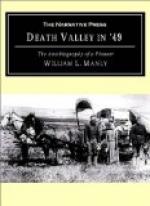They approached the base of the mountain in front of what they had all along supposed to be a pass, and found, as they had lately begun to suspect, that there was no pass that their wagons could be taken through, and they must be abandoned. The camp was poor. What little water there was had a salty taste, and they could only find here and there a bunch of the poorest grass. The oxen stood around as if utterly dispirited, and would sometimes make a faint effort to pick up and eat some of the dry brush that grew around the desolate camp. This camp is now known to be in the northern part of Death Valley, but then they knew no names for anything, but if dreariness and absence of life, and threatened danger all around were any indication, they might well have named it Death Valley as was afterwards done by the party with whom the Author traveled.
The party had been brave till now, but when they realized that they must make pack animals of themselves, and trudge on, they knew not where, perhaps to only a lingering death, the keen edge of disappointment cut close, and they realized how desolate they were. They felt much inclined to attribute all their troubles to the advice of the Mormons. Some said that the plan was thus to wipe so many more hated Gentiles out of the way, and wishes were deep and loud that the Mormons might all be buried out of sight in the Great Salt Lake. They thought Lot’s wife must have been turned to salt in the neighborhood, everything was so impregnated with saline substances, and the same result might come to them. But the inherent manhood of the little band came to their relief and they determined not to die without a struggle for escape and life.
They killed some of their oxen, and took the wood of their wagons and kindled fires to dry and smoke the flesh so it would be light and easy to carry with them. They scattered all surplus baggage around the ground, carefully storing and saving the bit of bread that yet remained and dividing it equally among the party. They also divided the tea, coffee, rice and some such things, and each one agreed that he could not ask aught of his neighbor more. Knapsacks were improvised from parts of the wagon canvas, and long strips of canvas were made into a sort of pack harness for the oxen. It was a sad sight to see the strong and vigorous young men of a few days ago reduced to such straits; almost skeletons now, with no hope of nourishment to invigorate them. They made canteens by sewing a couple of small powder cans in cloth, with a band to go over the shoulders.




